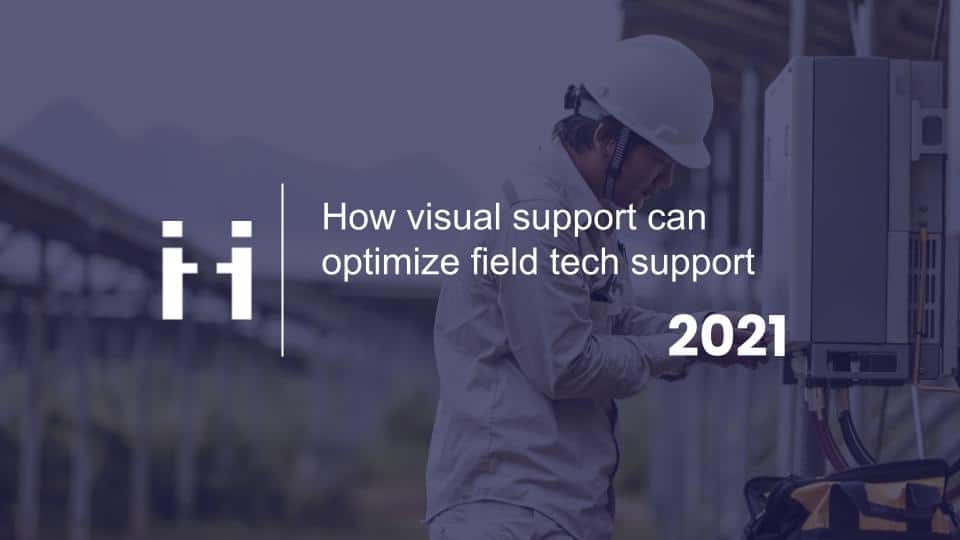
Share this article
Share this article
Nowadays, field tech support is a key component of business from a variety of industry sectors. Efficient field service management maintains healthy client relationships, boosts customer satisfaction, and drives revenues. For companies providing field services, augmented reality and visual support solutions are invaluable assets. Visual support is especially vital for field tech providers looking to minimize human error and provide superior support to clients.
Field tech support is essentially the on-site or real-time technical support provided by a company to ensure that its services and products are working correctly. Many organizations have physical assets scattered across different locations, with each of these assets and associated software requiring ongoing support from field technicians. Field tech support refers to any work carried out at customer locations to ensure software and product users enjoy a first-rate experience.
To fully leverage a piece of hardware or software, companies need access to reliable field service management. Many industries, including the IT sector and businesses from the technical field, rely on field tech support to meet the need of their customers. Any organization that offers field services to customers will depend on dispatch management to deploy technicians.

A field support specialist is a highly-trained technical professional who can tackle any issues customers experience with services and products as and when they arise. Typical duties of a technical support engineer include carrying out installation work, performing regular system maintenance, as well as tackling repairs both at commercial job sites as well as at the homes or companies of customers.
Many field specialists are also required to work closely with customers regularly, providing them with insights into products to ensure they’re getting the most out of them. They can provide tailored training to introduce customers to new products and take charge of workshops to ensure systems are being correctly utilized. The average field support specialist also needs to be committed to maintaining positive customer relationships. Most specialists will need to work closely with multiple teams and departments within an organization at any given time.
Any company looking to deliver efficient field technical support to customers needs to ensure their technicians have a full suite of tools at their disposal. One of the most important tools at any field technician’s disposal is visual support. Nowadays, the best field service organizations utilize visual support solutions as standard, but an increasing number are also turning to augmented reality to help optimize the support they can provide to clients.
Visual support tools allow you to connect with customers and field service workers, providing additional insights to ensure issues are diagnosed and remedied quickly. Visual support solutions also sometimes negate the need to dispatch a field technician to a client’s base of operations. By utilizing augmented reality solutions, technical support operatives can guide customers on how to apply fixes themselves.

When problems arise, customers and experts alike can follow the following steps to troubleshoot and resolve the issue.
1. Break the problem down into parts. What did you expect to happen when you performed a certain action, and what actually happened?
2. Use visual support tools to diagnose the situation. Once it’s clear that an issue is present, customers can use tools such as photos, live video, screen sharing, and more to show the experts what situation they are facing.
3. Resolve the issue remotely to avoid trips on-site. Experts can use collaborative visual tools and AR features to guide customers through the problem resolution process.
Optimizing field support services with visual support solutions benefits everyone. Customers can enjoy quick fixes to mission-critical systems and services, while tech support providers can more efficiently manage their workforce. Visual support can also be used to diagnose problems in advance. Many times, customers fail to sufficiently define an issue before a field support engineer is deployed to their location. By remotely connecting with customers beforehand, technicians can get a clearer picture of what needs addressing before arriving at a customer’s site.
Visual support allows you to do far more than guide a customer or field technician remotely. The best remote field service software makes full use of augmented reality features. This functionality can merge multiple video streams seamlessly, enhancing real-time communications so you can guarantee service delivery to your clients.
Technical support relates to the kind of help that experts provide to customers when they encounter challenges and issues with complex, technical products like machines, electronics, and software. Customer support, on the other hand, refers to each interaction that takes place between customers and customer service representatives from before the purchase, through to after-sales services. The goal is to make sure that every interaction that customers have with a company is positive.
Although some people use the terms customer support and technical support interchangeably, they are two very different roles. As many organizations tend to incorporate both roles into their infrastructure, it’s important to understand how they differ from one another.
Technical support is available to help customers who require assistance with a technical product, such as a piece of hardware or software. Generally speaking, technical support is only provided to customers who actively request it. Because of the demanding nature of the job, those based in technical support roles usually come with highly specialized skill sets and have been trained on the specifics of relevant software and hardware. A good technical support rep should be able to provide quick resolutions, simply by listening to the specific complaints of a customer.
Customer support roles are far more generalized. Customer support is on hand to assist customers who need help resolving a multitude of issues. Although there is occasionally some overlap with technical support, customer support reps typically guide product selection, package upgrades, payment queries, and more.
More companies than ever are offering add-on field tech support solutions to clients, ensuring they get the best out of products and services. However, seamless integration of field support is only possible with the right tools. Integrating visual support into your business model is by far the easiest way of ensuring your field tech support solutions are as efficient as they can be. It can be used as a pre-diagnostic tool to save field technicians valuable time, or as secondary support to provide additional insights. Used effectively, it can also eliminate the need to dispatch technicians to off-site locations entirely.

Free E-book available now!